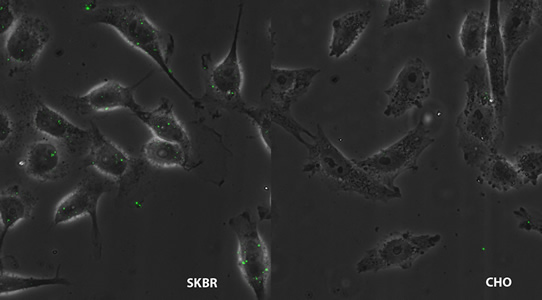Background-free optical imaging of breast cancer cells labelled with upconversion nanoparticle biocomplexes
We tested our bottom-up approach of assembling luminescent nanoparticle biocomplexes that can be target-delivered to specific cells. An upconversion nanoparticle (UCNP) was chosen, as the luminescent nano-core of the biocomplex, due to its unique luminescent properties that allow almost complete suppression of unwanted optical background. Mini-antibodies scFv4D5 were chosen as the targeting vector due to their high affinity to breast cancer cells (SK-BR-3), more specifically, these cell receptors HER2/neu, which were known to populate the cell membrane in great numbers, much greater than in normal cells, e.g. Chinese hamster ovary (CHO) cells used as the negative control. The biocomplex was assembled by using a versatile molecular linker barnase:barstar (Bn:Bs) [1], so the entire complex is represented by the following short-hand notation: UCNP-Bs:Bn-scFv4D5. Figure shows the results of the specific delivery of our biocomplexes. The breast cancer cells are successfully labelled with the biocomplexes, whereas the control CHO cells were not, which proved the potency of our approach and showed the promise of our technology.

Figure. Epi-luminescent microscopy of (left panel) breast adenocarcinoma cells (SK-BR-3) that over-express HER2/neu and (right panel) Chinese hamster ovary (CHO) cells incubated with UCNP-Bs:Bn-scFv4D5 biocomplexes. Upconversion nanoparticles provide the luminescent contrast, which is rendered green colour, and clearly observable in SK-BR-3 (SKBR) cells, not in CHO cells.
1. Sreenivasan VKA, Ivukina EA, Deng W, Kelf TA, Zdobnova TA, Lukash SV, Veryugin BV, Stremovskiy OA, Zvyagin AV, Deyev SM: Barstar:barnase - a versatile platform for colloidal diamond bioconjugation. Journal of Materials Chemistry 2011, 21:65-68.